Type 024 Hoku class FAC (1965)
 PCFG Houku/Hegu Class, Type 024 aka Project 24/EM1A.
PCFG Houku/Hegu Class, Type 024 aka Project 24/EM1A.
Chinese PLAN (1968-77) – about 110 built
The Chinese “Komar”
The Type 6623 was one of the Type five boats transferred from the Soviet Union to China according to the “Twenty-Four Agreement” between China and the Soviet Union in 1959. It was known as Proyekt 183R (NATO Komar), guided-missile speedboat in Soviet Navy nomenclature. It was using a wooden hull, like the 6602 torpedo boat she was based on, but its torpedo tubes were exchanged for 2 “Styx” anti-ship missile launchers. The rear deck was modified to cope with the launching airflow and covered with a layer of rigid Heat-resistant patterned aluminum plate. The original open bridge was modified into a steel airtight pilot and command room, so that bridge personnel could take refuge in it when launching missiles.
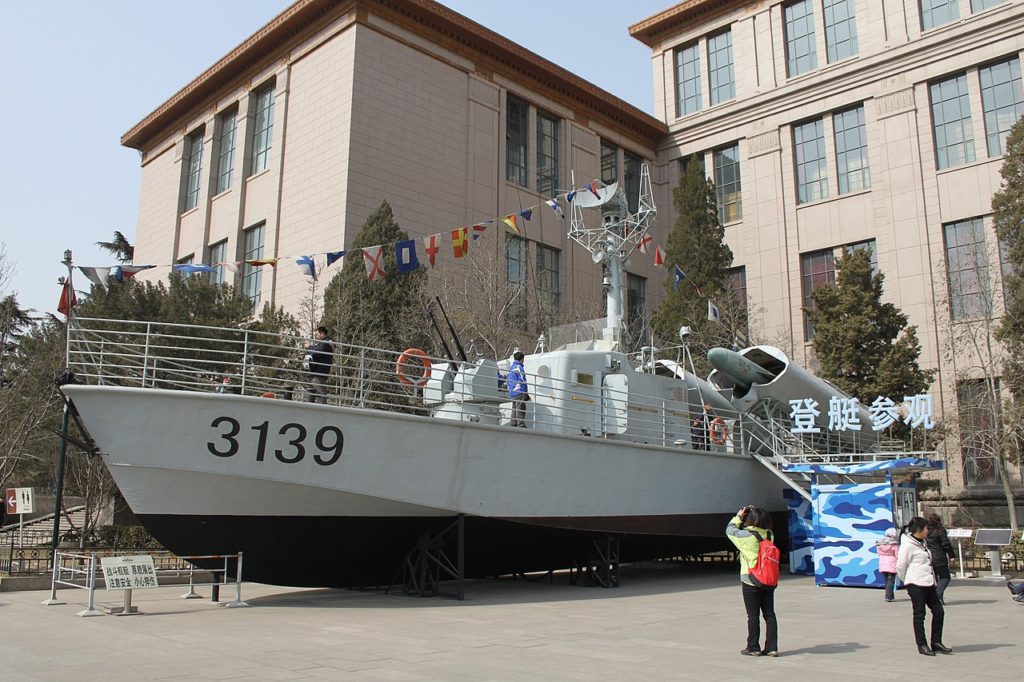
Preserved Type 024 missile boat #3139 at the PLA’s coastal forces museum.
Development timeline
In the 1950s, the Soviet Leningrad-Petrovsky Shipyard converted a P6 class torpedo boat into a missile boat with a displacement of 70 tons and 40 knots, creating the first guided missile boat in the world. This became the “Komar class” (NATO).
In 1960, according to drawings and materials provided by the Soviet Union to China, the Wuhu Shipyard started trial production of the Komar (“Mosquito”). Due to the withdrawal of experts from the Soviet Union as Sino-Soviet diplomacy broke off, supplies also abruptly stopped. By completing the blanks, the institute was able to complete a first prototype boat, number 051, launched in August 1962. Technical problems were encountered during the sea trials. For example, the trim angle of the hull was too large due to the weight of the missile aft. Its speed as also too limited as the power of the main engine remained unchanged while the displacement rose.
The severe vibrations of the hull al affected missile aiming and this affected also the radar operating conditions. After solving all these problems, the final prototype boat was delivered to the navy in August 1964 for acceptance trials. In 1965, the prototype tested missiles for the first time. Soon after, two more tests ships of the type 6623 were built. By that time engineers identified the wooden hull of the boat to be difficult to maintain in China, other solutions had to be found to prevent corrosion and replication of equipment previously imported from the Soviet Union was not yet complete.
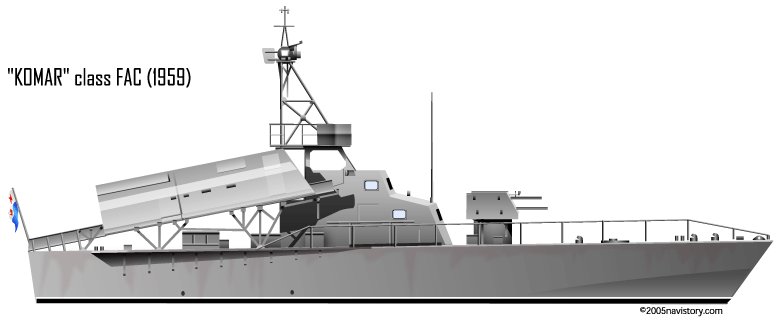
The Komar class (Author’s illustration)
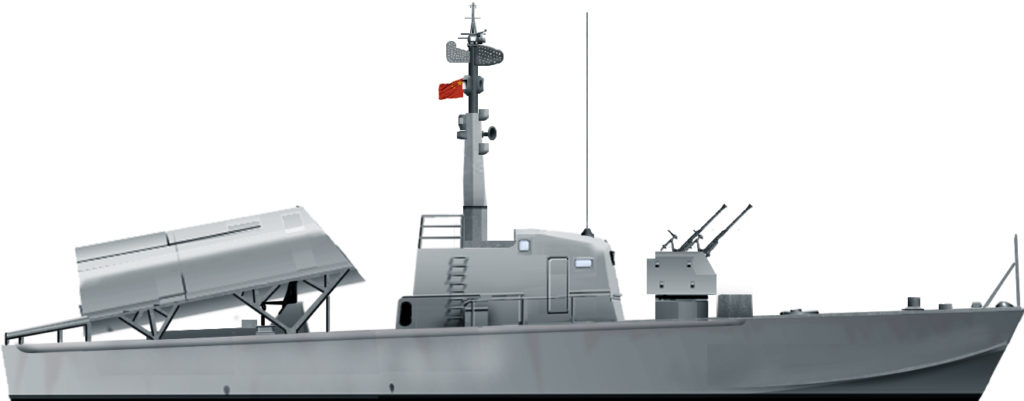
Hoku class, author’s illustration to compare
Genesis of the Type 6624
In November 1964, already the PLAN admiralty and Office of National Defense Industry ordered the 701 Research Institute to develop the Type 024 missile speedboat as an imprved version of the Type 6623. Hua Qiru presided over the design. The main purpose was to create a new steel hull, with underwater line also optimized, side platform eliminated, width narrowed to achieve greater speeds, as well as the hull lengthened for the same effect. Lateral distance between the missile launcher was shortened from 1.5 meters to just 1.0 meter. Also the main mast of the truss was changed to a single column mast. Chief architect Wu Zhongyan helped to design with his team the first boat of (future) Type 024 speedboat, in only 5 months. Construction of the prototype started in April 1966. It was launched in August 1966 and tested missiles in October 1966. These tests ere successful to it was delivered in December. Production however at that time was severely affected by the Cultural Revolution. It was not until 1971 that mass production was ramped up at the Wuhu and Shanghai Qiuxin Shipyards. Production ended in February 1975.
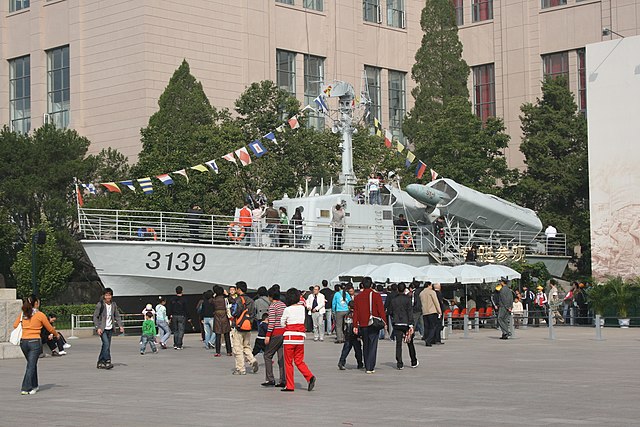
Type 024 missile boat exposed to the public
Design of the Type 024 Hoku
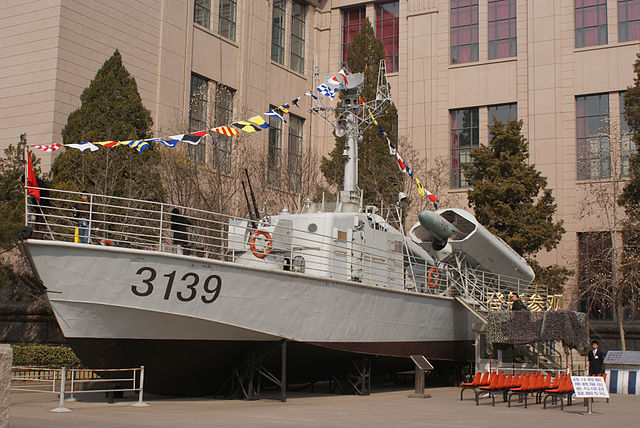
The Type 024 missile boat is designed and manufactured by China on the basis of the Type 6623 “Mosquito” class missile boat. In August 1962, the first imitation of the Type 6623 guided missile boat was launched at Wuhu Shipyard. However, during the sea trial, some problems with the boat were discovered: the trim angle of the boat was too large, it could not meet the navigational requirements when launching missiles, the speed could not go up, and the radar and command instrument were not working properly. The replica boat of the 6623 type boat is actually a scientific research boat. Since then, Chinese scientific and technical personnel have redesigned and modified the boat, such as moving the gyro platform of the commander part to reduce vibration, replacing radar components, and ensuring its normal operation. At the same time, the hull of the boat has also been greatly improved.
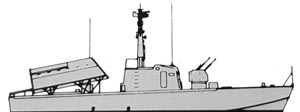
Conway’s profile of the Hoku class
First, the wooden structure of the original boat was changed to an all-steel structure. Measures were taken to reduce resistance and trim angle. A wedge plate was added to the stern to increase the size of the boat. The tail buoyancy finally solves the problem of navigation and satisfies the requirements of launching missiles. Afterwards, the propeller was redesigned, and the speed of the boat and the speed of the main engine also reached the requirements, which greatly increased the speed of the boat. This newly designed one type boat is the Type 024 missile boat. Since then, the boat has undergone many major improvements in accordance with the requirements of the Navy. In 1966, after completing a series of work procedures such as launching, sea trials, and missile tests, the Type 024 missile boat formally entered the Chinese People’s Liberation Army Navy and participated in combat readiness duties.
The Heku (“Hoku”) class is in fact the name of the main version of Type 024 missile boat. It is also called Hegu class, Hogu class, Hougu class or Houku class, depending on spelling and pronunciation. “Hoku” is the reference from Conway’s so i stuck to it. The Chinese brought many innovations to the Komar, which formed a large part of the “green water” navy, essentially defensive, that Characterized the plan in the years 1980s. The first was acquired in 1965, two were delivered in 1967, and seventy in the 1968-71 period. The building program was swift as about ten were built per year. The steel hull, quite an improvement over the Komar, was designed by the 701st Institute (Wuhu). The missile launcher was also brand new, designed by the 713th Institute. Some reports suggested that China provided Iran 10 Hegu Class fast assault boats with the C-802, but these appear to confuse the delivery 10 Houdong (a variant of the Huangfeng) missile boats, and has been debunked since. An export variant of the standard Houku/Hegu Class was also offered with 4 C-801 SSM launchers in place of the original 2 HY-2 launchers (no sells). This helped modernizing the last remaining in service.
Armament
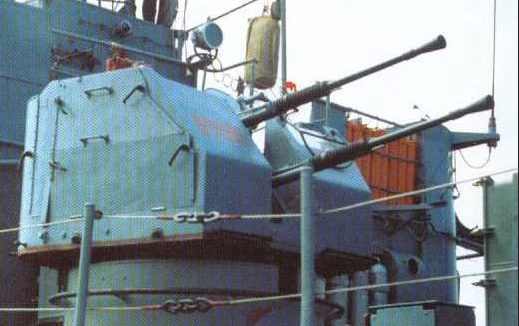
2M3 AA guns: The distinctive forward mount twin tandem 25mm/80 2M-3. This gun was based upon the 84-KM designed in 1943-44, from specifications developed in 1945-1947, tested in 1949, accepted in 1953 as 110-PM and manufactured in several variants until 1984. These were fed from 65-round belts or 7-round clips and designated 2M-3, later modified into 2M-3M with gas-operation recoil pistons and 470 – 480 rpm. The Chinese version is a faithful copy of 1959, weighting 101 kg with a 80° elevation, 2.8 km range (antiship role) and a ceiling of 1.7 km.
HY-2 Missiles:
The Shang You or SY-series and Hai Ying or HY-series (‘Sea Eagle’) were early Chinese anti-ship cruise missiles derived from the Soviet P-15 Termit. NATO designation is Silkworm.
Dimensions: 7.48 m, Diameter 0.76 m, Wingspan: 2.4 m.
Launch weight: 2,998 kg
Warhead: 513 kg, shaped charge high-explosive
Propulsion: Liquid rocket engine and one solid rocket booster
Speed: Mach 0.8, Range 200 km, altitude below 20 m
Guidance: Inertial + active conical scanning terminal guidance radar, single-shot hit probability: 90%
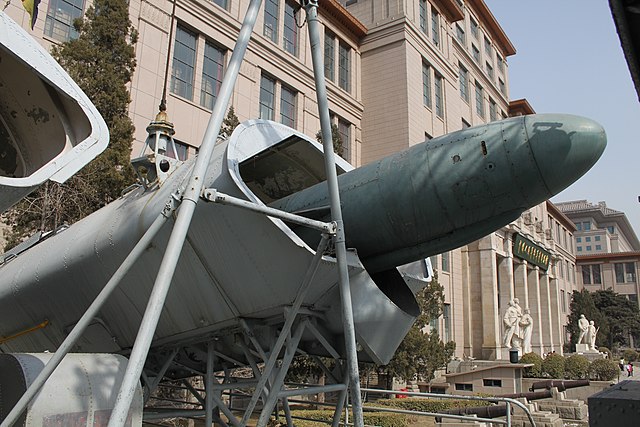
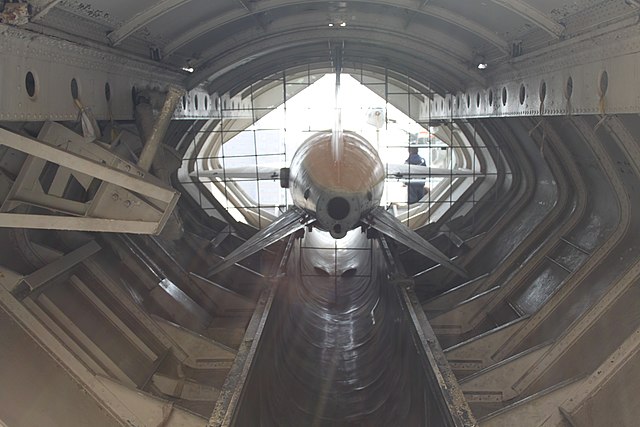
Specifications type 024 Hoku |
|
| Dimensions | (88.6 x 20.7 x 4.3 ft) |
| Displacement | 79.2 long tons FL |
| Crew | 17 (2 officers) |
| Propulsion | 4 shafts L-12V-180 diesels 4,800 hp(m) (3.53 MW)/td> |
| Speed/Range | 37.5 kts, 400 nm at 30 kts |
| Armament | twin 25mm/80 (2M-3) AA, Two HY-2/C-201 SSM |
| Sensors | Radar Square Tie (Type 352E) missile FCR, IFF |
Derivative: The Homa class
In addition to the development of the Hoku class missile boat, a single unit of Type 024 production fitted with hydrofoils was also developed. It was called the Homa class missile boat, but the design proved to be less satisfactory. The single unit delivered to the People’s Liberation Army Navy for evaluation, was later removed from service.
Also referred to as Project EM1B, its hydrofoil seems on paper a way to achieve greater speeds, at 40-45 knots and more. But this was never achieved. It is unclear why the project was discontinued. The Homa class was offered for export in 1986, but no sales had been made.
Specifications: Length 28 m, Beam 6.6 m, Displacement 85 tons FL, four shafts, M50 diesels for 5,600 bhp, 38 knots, endurance 500 nm at 25 kts, crew 20, a single twin 25mm/80 cal (2M-3) AA gun forward, two HY-2/C-201 missiles. Radar “Square Tie” (Type 352E) for surface search and missile fire control radar.
Operation

The main cabin id divided into operating compartments for the four 4 electromechanical operators of the missiles, two per rear cabin. The front as the rear of the hull, below the deck, is also separated into four compartment, two crew compartments at the front, and two at the rear, housing the two main engines and one auxiliary engine. Forward is located the former main cabin squad leader. The engine chief, a non-commissioned officer is in the battle position on the bridge, as the firing officer. He executes the captain’s order and transmits it to the engine room through the bell and light signals. The average temperature in the engne room was about 50°C, while the diesel engines noise make it difficult to endure on the long run. Vibration could reach, when at full speed, up to 1100 Hz, consistent with the resonance frequency of the ship, helping not making it break apart. However when engine pitch is accelerated, there was a set limit at 1100 rpm for safety. It could be overruled only for emergency, otherwise the hull could be severely damaged. Each time the engines passed 1,100 rpm, the hull could shake violently, marring all accurate missile launching and making impossible to read any instrumentation, damage the radar antenna, while badly shaking the crew in the process.
Before the missile is launched, all crew members must enter the bridge, to escape the blast and heat wave. After the missile is launched, the boat returned to port for a revision and some repainting of the burnt launcher, bridge, and rear deck. Daily work at dock included: Daily inspection, weekly inspection, monthly maintenance, half-year maintenance, and annual maintenance. In the annual maintenance, the guided missile boat is pulled out of the water, placed on a shelf for scrapping. The paint, notably the underwater highly toxic paint is removed down to the stell coating, a hammer is used to knock out rust in some area, and a wire brush and sandpaper are used to polish it until the steel plate is smooth as a mirror. A primer is applied, then the anti-rust paint, and highly toxic boat primer. All four main engines must be lifted out too, sent to the repair shop for a complete inspection and overhaul.
Currently known numbers of boats in service were: 615, 1103, 1108, 2128, 8107, 9104, 9106. In the 1990s, Shidao Township in Rongcheng had a brigade with 4 boats per squadron. The Chinese Liberation Army Navy was equipped with 75 boats of which 50 were active, 25 in reserve. In the 1980s, the Type 024 III was developed, with two twin “Eagle Strike-8” anti-ship missile launchers, tested for design finalization.
Export & Service
The first missile FACs used by the PLAN were the Type 021 Huangfeng and Type 024 Houku classes. Both were derived from Soviet designs, respectively the Osa and Komar class. They filled the shore defence plans of the navy at the time,. taking advantage of their speed but only efficient in moderate weather. The later Type 037II Houjian class and Type 037IG Houxin class were much larger, assimilated to corvettes but only displacing about five hundred tons. The Military Balance for 1996-97 estimated the PLAN fielded “about 185” missile craft which included circa 100 large Type 021 Huangfeng-class, and less, circa 75 Type 024 Houku-class, plus nine Type 037IG Houxin-class, a ingle “Huang-class and all were retired within 15 years replaced by more–technologically advanced and capable vessels, including some stealth features.
The Chinese Komar was largely improved in its “Chinese pattern” but not battle-hardened as its model. The Komar was indeed put into actual combat: On October 21, 1967, the only destroyer of the Israeli Navy, “Eilat” was cruising in Lumara Bay, northern end of the Suez Canal when at 17:00, while 13 nautical miles north of Port Said she was spotted by Egyptian coastal radars. two “Kormar” boats were scrambled from Port Said and launched all their four missiles at the same time. They had 3 hits. “Eilat”, crippled, sank 10 minutes later. This was an historical first, showing than missile boat coild actually sink a large warship. Previously such occurrence happened in 1918 when two MAS boats torpedoed an Austro-Hungarian dreadnought.
During the Indo-Pakistani War in 1971, the Indian Navy’s own Komar boats attacked the Pakistani naval vessels and onshore oil depots near Karachi, launching 13 ship-to-ship missiles in total, of which 12 hit their targets. They sank the Pakistani destroyer “Khyber”, minesweeper “Muhamfez” and 3 patrol boats, crippling the destroyer “Badar” and No. 3 oil tanks set ablaze, with not a single loss.
This attracted attention especially in developing countries, as missile boats were relatively cheap and fit as a good replacement for the old MTBs (motor torpedo boats). Western powers until then did not pay much attention to the development of anti-ship missiles since artillery and torpedo still dominated minds. This made western navy’s revise combat thinking and tactics, by contesting their maritime supremacy. The Chinese Type 024 however was not tested in combat, although its potential is intact. More so, it was exported and the users might take it to action some day, until it is declare obsolete. So far this only concerns the Bangladesh Navy.
As of today, Chinese PLAN missile FAC fleet is wildly debated between sources. The Pentagon estimates is about 54 coastal-patrol (missile) craft in all. Only the 022s are su-detailed (22), not the other type. Since only the Type 022s, optimized for fast attack at high speeds for shorter periods are retained, it is likely the Houku are now all retired. The Military Balance of 2013 still lists four FACs types, for about 100 vessels including 66 Type 022s but says nothing of the Type 021 of 022 in the inventory. Allegedly ten were also exported to Iran (unconfirmed).
-Type 22 NATO designation: Houbei class, the first boat was launched with a steel hulled derivative as the Type 024 class for the Cuban Revolutionary Navy while 18 were provided to the Egyptian Navy (67 retired)
Bangladesh Navy:
-BNS Durdam for the Bangladesh Navy served from 1983 to 2017 (commissioned on 10 November 1983).
-BNS Duranta, commissioned on 6 April 1983, was in service until 2017.
-BNS Durvedya (commissioned 10 November1983) was also striken in 2017.
-BNS Durbar (commissioned 6 April 1983) was also retired that year.
-BNS Uttal was from the second batch, commissioned on 23 August 1992 but also retired the same year.
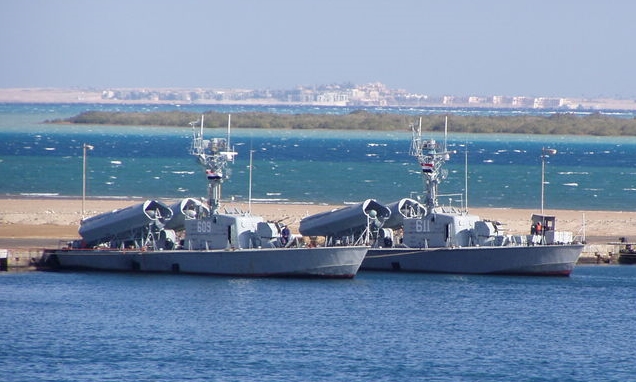
Chinese description:
The Type 024 guided missile speedboat, known as the “River Valley” class by NATO, is a fast-attack guided missile patrol ship built by the Wuhu Shipyard for the Chinese People’s Liberation Army Navy in 1960, with a total of six? ships. It was originally derived from the Soviet Union “6623” (“Komar” class) with a wooden hull, later changed to a steel shell, showing better speed and sea resistance. The boat had a low freeboard, 23mm/60 twin-barreled guns installed in position A, a low central superstructure; stout main mast on top of central superstructure ; “Square knot” air/sea search radar antenna is located on the top of the mainmast; 2 large anti-ship missile launchers are located on the rear deck, with the front edge raised and slightly inclined to the outboard. Remark 1: The Chinese improved version of the Russian “Comau” class patrol ship. Note 2: The Chinese-made hydrofoil modified ship has a semi-submersible hydrofoil front structure, and the length of the ship is 6 feet longer.
Read More
https://www.globalsecurity.org/military/world/china/hegu.htm
Labayle-Couhat, Jean. Combat Fleets of the World (1984-1985 ed.). Naval Institute Press. ISBN 978-0870211362.
Conways’ all the world fighting ships 1947-1995
The Dragon’s Teeth: The Chinese People’s Liberation Army—Its History By Benjamin Lai
Naval War College – Chna’s evolving surface fleet (Dutton, Martinson)
https://en.wikipedia.org/wiki/Type_024_missile_boat
bangladeshdefence.blogspot.com/2010/11/heku-class-fast-attack-craft-missile.html
http://www.globalmil.com/military/navy/china/corvettes_and_fac/2010/0315/177.html
Baidu search query

 Latest Facebook Entry -
Latest Facebook Entry -  X(Tweeter) Naval Encyclopedia's deck archive
X(Tweeter) Naval Encyclopedia's deck archive Instagram (@navalencyc)
Instagram (@navalencyc)





 French Navy
French Navy Royal Navy
Royal Navy Russian Navy
Russian Navy Armada Espanola
Armada Espanola Austrian Navy
Austrian Navy K.u.K. Kriegsmarine
K.u.K. Kriegsmarine Dansk Marine
Dansk Marine Nautiko Hellenon
Nautiko Hellenon Koninklije Marine 1870
Koninklije Marine 1870 Marinha do Brasil
Marinha do Brasil Osmanlı Donanması
Osmanlı Donanması Marina Do Peru
Marina Do Peru Marinha do Portugal
Marinha do Portugal Regia Marina 1870
Regia Marina 1870 Nihhon Kaigun 1870
Nihhon Kaigun 1870 Preußische Marine 1870
Preußische Marine 1870 Russkiy Flot 1870
Russkiy Flot 1870 Svenska marinen
Svenska marinen Søværnet
Søværnet Union Navy
Union Navy Confederate Navy
Confederate Navy Armada de Argentina
Armada de Argentina Imperial Chinese Navy
Imperial Chinese Navy Marinha do Portugal
Marinha do Portugal Mexico
Mexico Kaiserliche Marine
Kaiserliche Marine 1898 US Navy
1898 US Navy Sovietskiy Flot
Sovietskiy Flot Royal Canadian Navy
Royal Canadian Navy Royal Australian Navy
Royal Australian Navy RNZN Fleet
RNZN Fleet Chinese Navy 1937
Chinese Navy 1937 Kriegsmarine
Kriegsmarine Chilean Navy
Chilean Navy Danish Navy
Danish Navy Finnish Navy
Finnish Navy Hellenic Navy
Hellenic Navy Polish Navy
Polish Navy Romanian Navy
Romanian Navy Turkish Navy
Turkish Navy Royal Yugoslav Navy
Royal Yugoslav Navy Royal Thai Navy
Royal Thai Navy Minor Navies
Minor Navies Albania
Albania Austria
Austria Belgium
Belgium Columbia
Columbia Costa Rica
Costa Rica Cuba
Cuba Czechoslovakia
Czechoslovakia Dominican Republic
Dominican Republic Haiti
Haiti Hungary
Hungary Honduras
Honduras Estonia
Estonia Iceland
Iceland Eire
Eire Equador
Equador Iran
Iran Iraq
Iraq Latvia
Latvia Liberia
Liberia Lithuania
Lithuania Mandchukuo
Mandchukuo Morocco
Morocco Nicaragua
Nicaragua Persia
Persia San Salvador
San Salvador Sarawak
Sarawak Uruguay
Uruguay Venezuela
Venezuela Zanzibar
Zanzibar Warsaw Pact Navies
Warsaw Pact Navies Bulgaria
Bulgaria Hungary
Hungary

 Bundesmarine
Bundesmarine Dutch Navy
Dutch Navy Hellenic Navy
Hellenic Navy Marina Militare
Marina Militare Yugoslav Navy
Yugoslav Navy Chinese Navy
Chinese Navy Indian Navy
Indian Navy Indonesian Navy
Indonesian Navy JMSDF
JMSDF North Korean Navy
North Korean Navy Pakistani Navy
Pakistani Navy Philippines Navy
Philippines Navy ROKN
ROKN Rep. of Singapore Navy
Rep. of Singapore Navy Taiwanese Navy
Taiwanese Navy IDF Navy
IDF Navy Saudi Navy
Saudi Navy Royal New Zealand Navy
Royal New Zealand Navy Egyptian Navy
Egyptian Navy South African Navy
South African Navy






























 Ukrainian Navy
Ukrainian Navy dbodesign
dbodesign